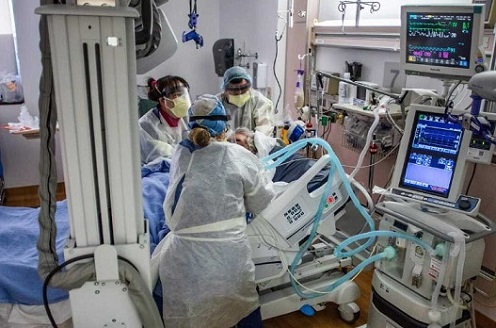Nikhil Prasad Fact checked by:Thailand Medical News Team Aug 05, 2024 8 months, 3 weeks, 18 hours, 4 minutes ago
COVID-19 News: A Dramatic Increase in Hospitalizations
In a surprising turn of events, South Korea experienced a sharp rise in COVID-19 hospitalizations throughout July. According to the Korea Disease Control and Prevention Agency (KDCA), the number of hospitalizations climbed steadily: from 63 in the last week of June to 91 in the first week of July, 145 in the second week, and a staggering 225 in the third week. By the end of July, hospitalizations had reached an alarming total of 465, marking a more than fivefold increase within the month.
 South Korea's COVID-19 hospitalizations skyrocket in July
Pandemic Measures Eased Too Soon?
South Korea's COVID-19 hospitalizations skyrocket in July
Pandemic Measures Eased Too Soon?
This surge comes on the heels of South Korea's decision to lower its COVID-19 crisis level from “alert” to “interest” on May 1. This downgrade was made by the Central Disease Control Headquarters in response to a significant decline in confirmed cases earlier in the year. South Korea's approach mirrored that of other countries, such as the United States and Japan, which also lifted their emergency response systems as global conditions appeared to improve.
However, the rapid escalation in hospitalizations raises questions about whether these measures were eased too soon. The decision to downgrade the crisis level may have been premature, considering the recent spike in severe cases.
The Numbers Behind the Surge
The data from KDCA as reported by local
COVID-19 News coverages, highlight the severity of the situation.
https://news.koreaherald.com/view.php?ud=20240804050199
In the first week of July, 91 patients were hospitalized with COVID-19. By the fourth week, this number had surged to 465. Throughout July, a total of 929 patients required hospitalization due to the highly contagious respiratory disease.
This sudden rise in hospitalizations has prompted health officials to reconsider their strategies. A senior official from KDCA announced on August 1 that COVID-19 vaccinations for those aged 65 and above would resume in October, indicating a proactive step towards controlling the spread among the most vulnerable populations.
From Pandemic to Endemic: The Transition
In May 2023, South Korea transitioned from a pandemic to an endemic status. This shift led to the lifting of several restrictions, including indoor mask mandates in most places. This decision marked the end of over three years of stringent measures aimed at controlling the virus.
Since the onset of the pandemic in January 2020, COVID-19 has claimed the lives of 35,934 people in South Korea. The country, with a population of approximately 51 million, has reported over 34.5 million infections during the same period.
The Way Forward
The recent surge in hospitalizations serves as a stark reminder that the COVID-19 pandemic is far from over. While the trans
ition to endemic status and the lifting of restrictions brought a sense of normalcy, the virus continues to pose a significant threat.
Health authorities claim that the resumption of vaccinations for the elderly in October is a crucial step in mitigating the impact of the virus. Health officials are likely to monitor the situation closely and adjust strategies as needed to prevent further spikes in severe cases and hospitalizations.
Conclusion
South Korea's recent experience highlights the unpredictable nature of COVID-19 and the need for continued vigilance. As the country navigates the complexities of managing an endemic virus, the health and safety of its citizens remain paramount. The surge in hospitalizations serves as a critical reminder that the fight against COVID-19 is ongoing, requiring sustained efforts and adaptive measures to safeguard public health.
For the latest
COVID-19 News and related health measures, visit Thailand Medical News. Stay informed, stay safe.
Read Also:
https://www.thailandmedical.news/news/u-s-medical-news-covid-19-hospitalizations-rising-in-arkansas
https://www.thailandmedical.news/news/u-s-medical-news-san-diego-s-covid-19-positivity-rate-reaches-20-5-percent
